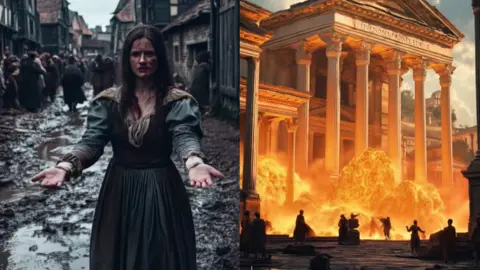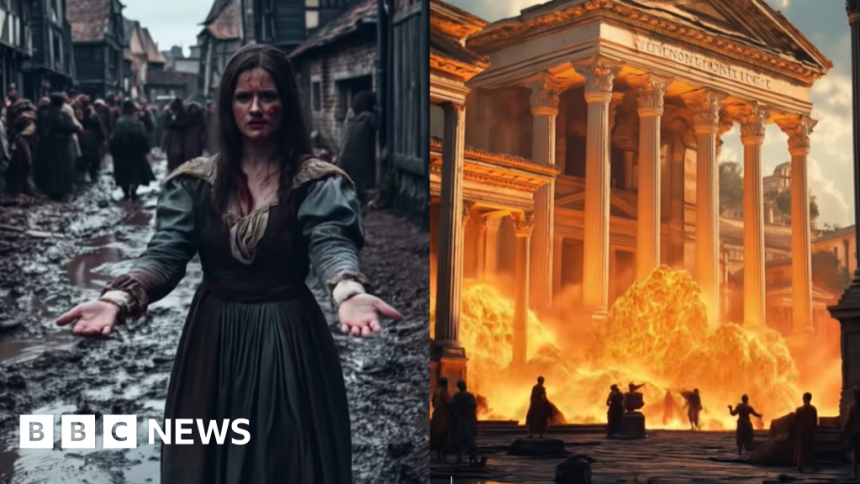‘Amateur and dangerous’: Historians weigh in on viral AI history videos
 timetravellerpov
timetravellerpovImagine waking up in Rome 2,000 years ago, on the Nile in ancient Egypt or on the streets of London during the Black Death in the 1300s – complete with realistic sights, sounds and daily struggles.
In recent weeks, AI-generated videos showing the points of view of people waking up in different historical time periods have gone viral on TikTok.
Dan and Hogne are the creators behind two of the accounts – POV Lab and Time Traveller POV.
Dan, based in the UK, tells the BBC he creates these videos as the “idea of seeing the past through a first-person perspective felt like a unique way to bring history to life”.
Hogne, a 27-year-old from Norway, adds that his videos are teaching people “about cool parts of history and helping them learn something new”.
Despite the videos offering millions a window into history, a number of historians have shared concerns about the accuracy of the content and whether AI can truly resurrect the past, or are we just seeing a polished, modernised version of history designed for engagement?
Allow TikTok content?
and
before accepting. To view this content choose ‘accept and continue’.
Murky and misty streets, coughing townsfolk, and the distant toll of a plague doctor’s bell all feature in Hogne’s most-watched video, which has racked up 53 million views.
It has sparked fascination among many, but historian Dr Amy Boyington describes the medieval-themed video as “amateurish” and “evocative and sensational” rather than historically accurate.
“It looks like something from a video game as it shows a world that is meant to look real but is actually fake.”
She points out inaccuracies like the depiction of houses with large glazed windows and a train track running through the town which wouldn’t have existed in the 1300s.
Historian and archaeologist Dr Hannah Platts has also noticed significant inaccuracies in a video depicting the eruption of Mount Vesuvius at Pompeii.
“Due to Pliny the Younger’s eyewitness account of the eruption, we know that it didn’t start with lava spewing everywhere so to not use that wealth of historical information available to us feels cheap and lazy.”
Allow TikTok content?
and
before accepting. To view this content choose ‘accept and continue’.
She also spots smaller mistakes – stemmed wine glasses and pepper mills didn’t exist and people would be reclining while eating not sitting on dining chairs.
“The bread roll in the video is a modern loaf and given we actually have carbonised loaves from the time it’s a real shame the person making the video didn’t do some research and include that.”
Dan, who created the video of Pompeii, says he recognises a lots of details in his videos are historically inaccurate.
“AI-generated content isn’t perfect, and while I strive for accuracy, these videos are more about evoking the feeling of a time period rather than being a 100% factual recreation.
“They’re more like artistic interpretations rather than strict documentaries.”
‘Manipulate history’
But, Dr Boyington worries about the impact that these artistic interpretations can have on rewriting history.
“It can be quite dangerous as people could manipulate history – for example, someone could create an AI-generated video that backs up holocaust deniers.”
While most people will know that the content of the video isn’t real, the concern is for “young people who will learn about a historical time period for the first time through these videos”.
Dan rejects these claims and says his videos “are not meant to be taken as pure historical fact”.
“I encourage viewers to research history themselves if they’re interested. I see these videos as a way to spark curiosity about the past rather than replace real historical education.”
Hogne says he feels “a responsibility” in creating these videos and has been focusing on trying to make the videos as accurate as possible, “especially now that so many millions of people are watching them”.
Dr Platts worries about misinformation spreading unchecked, noting that some viewers in the comments seemed unaware that the AI-generated videos were not based on historical facts.
“We see lots of students now using AI, and what’s problematic is if they see something like this and then it’s echoed back to us as if it’s fact.”
Dan says he ensures all his videos are labelled as AI-created, while Hogne says that misinformation has existed long before AI and “people have to think critically about everything they are watching”.
‘Can have immense benefits’
All the historians the BBC spoke to agree that there are merits to Dan and Hogne’s videos.
Dr Boyington says they can act as a “gateway into history and can inspire someone to do their own research”, while a professor of Egyptology, Elizabeth Frood, says that “if done accurately and reliably then this is of immense benefit to the public as it raises interest and awareness of history”.
Barbara Keys, a professor of US history at Durham University, took a look at an AI-generated video of someone working at the Chernobyl nuclear power plant on 6 April 1986, the day the reactor exploded.
While she sees the potential merits in these videos, she calls the clip a “black box” as there’s no source information or transparency about what information was fed to the AI programme.
She says a concerning inaccuracy in the video is that the retractor is based on images from after the disaster rather than before.
“This makes people think that Soviet technology was really bad when actually it was very sophisticated.”
She thinks the viral nature of these videos is less about their historical content and more about the public’s fascination with AI itself.
“There’s nothing very interesting in the video, and it doesn’t give you any information about the accident or what happened after, so the interest must be able what AI can do.”
Prof Frood has concerns that the videos haven’t been created accurately or reliably and emphasises that historical reconstructions should be based on extensive research and verifiable sources.
“We need to be critical of this video as we know nothing about its source or what information was fed to the AI in order for this video to be created.”
She is commenting specifically on a video about being a child in Egypt in 1250 BC.
Allow TikTok content?
and
before accepting. To view this content choose ‘accept and continue’.
The first thing that struck her was how the videos tend to “homogenise complex ancient worlds.”
“Egypt spans thousands of years, and people might not realise that this is just one snapshot,” she explains.
Overall she says the video seemed “poorly researched” and pointed out an instance where a teacher in a school scene is reading the hieroglyphs backward when they should be read from right to left.
Hogne, who created the video, says he recognises that there are historical inaccuracies in his videos and that’s because “AI can make a lot of errors but in the future the tools will get better”.
“I try and spot them where I can but I am not a history expert so I don’t always see the error, especially when it’s something small,” he adds.
Asked about the lack of transparency in source material, Hogne says in the future he might consider adding links to where he got his information from.
“It would be cool to make it totally accurate using the right sources, but it’s just me on my own making these videos and it takes eight hours to make each one.”
How do you create these videos?
Hogne relies on Chat GPT to research a time period and asks it for information about what people and places would have looked like. He then generates an initial image of someone looking out at a landscape and from there “it’s a lot of back and forth to get it right”.
Dan says it takes him four hours to make each video and he uses “different AI tools to generate high-quality images, animate them, and craft realistic sound”.
He watches videos and reads documents to educate himself on a time period before making the video to try and give it “some historical accuracy”.
“You have to give the AI every detail, from ‘traditional Italian robes’ to ‘cobblestone floors’ otherwise it will get creative and make random things you don’t want.”








